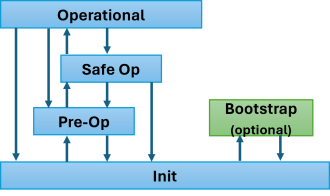EtherCAT State Machine
The state of each EtherCAT device is controlled via the EtherCAT State Machine (ESM). The possible states are listed below. These states are only for the EtherCAT communications of each device - drives and valves have additional state machines for their own operation.
When the EtherCAT network starts up, the MainDevice and SubDevices go through the ESM states in this order: Init → Pre-Op → Safe-Op → Op
All devices in the network must be in Op mode for proper operation. If any device is not in Op mode, the Process Data on the entire network may be invalid. In the future, the RMC may support multiple Sync Units, in which case, all SubDevices in a given Sync Unit must be in Op mode for that group to operate properly on the network. SubDevices in a given Sync Unit may be in states other than Op mode, and it will not affect other Sync Units.
States
The possible EtherCAT communication states for devices on the network are:
-
Safe-Op
In the Safe-Operational state, only input process data is communicated. The RMC will be able to see the position feedback and other info from drives and sensors, but it may not list the data as valid. The RMC cannot send data to SubDevices. Drives, valves and outputs will not be able to operate.
-
Op
The Operational state is the normal state of operation. Input and output process data is communicated. The RMC can see position data and other info from all devices, and send output data to drives, valves, and outputs. Drives and valves can operate as normal.
Viewing and Changing EtherCAT States
To view the current state of a device:
-
In the EtherCAT Editor, on the toolbar, click the Start EtherCAT Diagnostics button.
button.
-
In the EtherCAT Explorer pane, select the MainDevice or a SubDevice.
-
On the General tab, the MainDevice State or SubDevice State section displays the state.
To change the current state of a SubDevice:
Use the buttons in the Change SubDevice State section. If the device does not successfully change to the requested state, there is some issue with the device configuration.
To change the current state of the MainDevice:
Use the buttons in the Change Target State section. In order to change to a higher state, all SubDevices must be able to change to the higher state. If any SubDevice is not able to enter the requested Target State, the MainDevice will remain in a lower state.
Init Commands
When the SubDevice transitions between states (which occurs most often after the network starts up), various commands are executed in each SubDevice. These commands are generally for configuring the SubDevice. Many Init commands are set on the transition from Pre-Op to Safe-Op, such as the Mode of Operation for drives. Most Init commands are automatically created and the user typically does not need to create any. The Init commands are listed in the EtherCAT Editor, on the Init Commands tab of each SubDevice.
For more details, see EtherCAT Init Commands.
State Transition Details
When the EtherCAT network starts up, the MainDevice and SubDevices are in the Init state. The MainDevice and SubDevices go through the ESM states in this order: Init → Pre-Op → Safe-Op → Op.
Each state can fall back directly to any lower state, but a higher state can be obtained only in the order indicated by Init → Pre-Op → Safe-Op → Op. For example, if a SubDevice is in Pre-Op mode, it can reach Op mode only by transitioning to Safe Op mode, then to Op mode.
The following diagram shows which state transitions can occur:

The MainDevice can only reach the highest state of all the SubDevices. The Bootstrap state is only for SubDevices.
Troubleshooting EtherCAT States
As described in the Viewing and Changing EtherCAT States section above, use the EtherCAT Diagnostics window, General tab to view the state of each device on the network.
The Event Log also displays a EtherCAT MainDevice state transition entry when the MainDevice transition between states.
If a SubDevice is not entering the requested state, there may be a configuration problem with the SubDevice. You may need to use the configuration software for the SubDevice to determine the problem. You may view more SubDevice data on the CoE Object Dictionary tab in the EtherCAT Diagnostics window, which may provide more details about the device status.
See Also
Init Commands | EtherCAT Overview |EtherCAT Diagnostics
Send comments on this topic.
Copyright © 2025 Delta Computer Systems, Inc. dba Delta Motion
 button.
button.